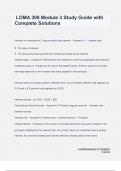Exam (elaborations)
LOMA 308 Module 3 Study Guide with Complete Solutions
LOMA 308 Module 3 Study Guide with
Complete Solutions
Interest on investments, 3 factors affect their growth - Answer️️ -1. Interest rate
2. The type of interest
3. The time period during which the invested principal earns interest
Interest rates - Answer️️ -Remember that interest is a...
[Show more]
Preview 4 out of 79 pages
Uploaded on
September 15, 2024
Number of pages
79
Written in
2024/2025
Type
Exam (elaborations)
Contains
Questions & answers
Institution
LOMA 308
Course
LOMA 308
R236,15
Also available in package deal from R285,12
100% satisfaction guarantee
Immediately available after payment
Both online and in PDF
No strings attached
Document also available in package deal (1)
LOMA 308 Exam Bundle Pack Questions and Answers | 100% Pass
R 491,20
R 285,12
2 items
LOMA 308 Module 3 Study Guide with




